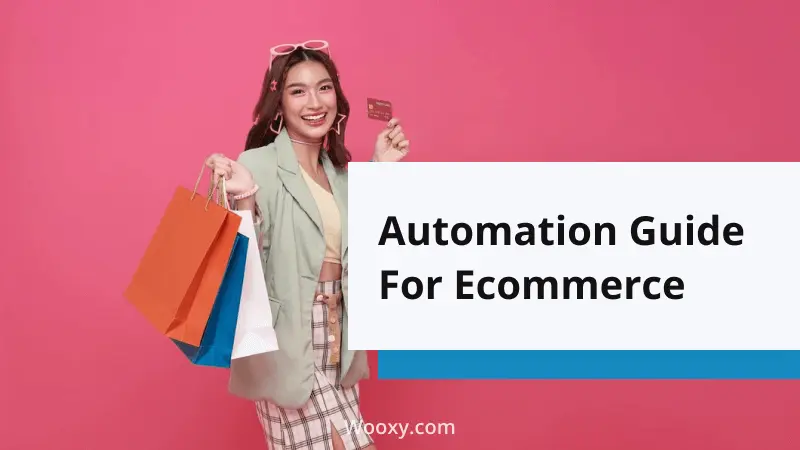Marketing Automation Guide for E-commerce
Marketing automation is responsible for simplifying many e-commerce operations. Through e-commerce marketing automation best practices, businesses can make their work seamless without additional effort. That is exactly why more and more stores are re-evaluating their approach. Now, marketing automation is the new norm.
Below, we will present a comprehensive guide on e-commerce marketing automation. You will learn what it is, how to use it in your business, and its benefits.

What is Marketing Automation?
E-commerce marketing automation is a set of tools and tactics that help automate certain tasks in marketing. By leveraging technology, the company can avoid using human force, thus transforming its workflow.
The software will handle all repetitive tasks like email campaigns, customer segmentation, social media management, and lead nurturing, leaving more time for other important tasks.
The Role of Marketing Automation in E-commerce
Tools used for marketing automation can greatly benefit customer relationships by segmenting the customer base by purchase history, demographics, location, and more. In addition to this, they can streamline the store’s email marketing. Established workflows enable A/B testing, too, improving conversion rates at a fast pace.
E-commerce businesses can easily scale their operations through marketing automation. No manual intervention is required that way, so the employees can focus on other responsibilities at hand.
Why E-commerce Businesses Need Marketing Automation
Managing an e-commerce business takes a lot of time and effort. All the manual work can be daunting, both for you and your staff. Specialized software can spare you from the boring parts of the work, like sending emails and generating leads.
All e-commerce businesses need to try marketing automation to:
save time and energy when handling daily tasks;
enhance customer engagement;
collect and sort information for efficient data-driven decision-making;
improve sales performance.
These are only the main benefits of using tools and apps in your marketing strategy. We will return to this topic after touching on key features.
Key Features of Marketing Automation for E-commerce
Whether you are trying to make your business more efficient or cut costs, automation can aid you in all tasks regarding marketing. Let’s unpack each feature and understand how it works in e-commerce.
Customer Segmentation
Depending on the customer’s past actions, purchases, and preferences, the tools you use will put them into different segments. Customer segmentation will help you understand what your clients want to buy next, their pain points, and potential solutions.
You can leverage that knowledge when building future campaigns for tailored customer experiences. If one campaign doesn’t work, you can put the software to the test with a different idea right away.
Email Marketing Automation
Email marketing is also a huge part of personalization and tailored experiences. Thankfully, you can automate this part of your business, too. Clients enjoy receiving messages and discounts tailored exactly to their needs, so using the information you gather in your automation strategy is essential.
Successful data implementation is what makes it popular. Action rewards, follow-up emails, abandoned cart reminders, specialized offers – all of that makes your audience feel appreciated.
Lead Nurturing
There are traditional client journeys, as all marketing professionals know. Yet, most of them are outdated. Nowadays, most customers take unique steps to get the product your e-commerce business sells, which makes lead nurturing pretty challenging. That is where automated lead nurturing steps in, creating useful practices to reach potential clients.
Automated Workflows
Automating boring tasks is the main benefit of switching from manual labor. Several processes in every business department can be done by AI. If software, apps, or technology can do it better and unload your employees, add it to your new automated workflow.
Repetitive tasks like customer onboarding, sending birthday emails, and crafting promotional offers are better done by software. Not only will this benefit the staff and the company, but it will also improve time management. However, remember that automated workflows are about productive work, not laying off your employees.
A/B Testing and Optimization
If you are not sure that your email or website design is quite right, let the automation handle it. After all, the technology can also do A/B testing and optimization for you. Split testing, the process of comparing two versions of the same website or product, will help you determine which variant your users prefer.
Before, you could use the tools to test that. Then, you would perfect your website or app design and any copy or product you have and tailor it to customers’ needs. Now, the app or tool will do most of the work for you, optimizing the process based on its performance.
CRM Integration
E-commerce is an amazing idea, regardless of your goal. Whether you are starting a completely new business or opening an online department for your brick-and-mortar business, marketing automation will benefit it in more ways than one. That includes integration with CRM systems.
This will automate the way data you have collected connects to your marketing channels, leaving no place for human error. Tracking customer interactions, personalizing communications, and managing leads will be simple and seamless.
Benefits of Marketing Automation in E-commerce
Now that we have discussed the main features of marketing automation, it’s time to talk about the benefits of including technology in your marketing strategy. From increased efficiency and improved retention to higher revenues and sales, we will explain each benefit below.
Increased Efficiency and Scalability
Once marketing automation is established, your marketing team can finally work on their tasks. They will be able to discuss new strategies, improve already existing campaigns, and optimize products. Automation reduces unnecessary manual labor.
Moreover, it uses technology to handle new work. Even if the volumes are bigger, it will still be able to process everything, unlike real people. So, you will be able to scale your business without burdening your employees or hiring new ones. Automation lets you use the same resources for better results.
Improved Customer Engagement and Retention
Talking to your customers might be challenging when your team does everything manually. Yet, it gets much more comprehensive when software completes most tasks for you.
With marketing automation tools, you can:
collect and compile customer data at any given time without manual entry;
create new loyalty programs with a tiered system;
spot your top customers;
send offers and rewards to clients of your choice;
collect customer feedback and respond to it;
identify changes in purchase history and engagement rates.
As you get better at interacting with your clients, it improves customer experience and engagement, leading to higher retention rates.
Enhanced Personalization and Targeting
Once you automatically collect all the data you need, you can work on your personalization and targeting strategy. You no longer need an employee to do this, as your tools can do everything for you.
Thanks to that, your e-commerce business can handle personalized emails and messages based on client history. Inspect their behavior, and buying patterns to craft a perfect targeted marketing strategy.
Boost in Sales and Revenue
In e-commerce, a lot of returns stay unrealized. Most customers will come to your store without the intention of buying anything. Others will forget to check out, leaving their carts abandoned. Some clients will opt for a cheaper option, even though they would rather invest in a high-quality product.
With the right tools, however, you can redirect your potential customers back to the store and guide them to the right product. Abandoned cart emails, for example, can recover up to 11% of lost sales for e-commerce businesses. Upselling and cross-selling emails will present your customer with premium versions of the same product, winning you additional sales.
You can do all this without manual work. With marketing automation, these marketing campaigns contribute to higher conversion rates and increased revenue with little to no effort.
Data-Driven Insights and Analytics
Once businesses think about personalization, they realize they have to collect and analyze a ton of data. Automation allows them to leverage artificial intelligence and machine learning to avoid doing repetitive tasks.
Your software will collect various information from digital marketing channels such as social media and marketing email campaigns, surveys, and reports. Then, your team will be able to track customer behavior, sales trends, and campaign performance to optimize your future business endeavors.
Consistent Branding and Messaging
Strong branding is one of the cornerstones of e-commerce. Unless you build consistent brand messages, your potential client will fail to recognize you, losing your store in the crowd. By leveraging marketing automation, you can stay consistent with your branding across various channels and campaigns.
With the right tools, you can keep a strong style of text and visuals, communicate across all marketing channels at once, and boost your brand reputation. In turn, your clients will remember your store and products.
How to Implement Marketing Automation in E-commerce

You must be excited to try the tools and software and benefit from automating your business. There are several steps you should take before you download the applications and teach your employees automation tactics. Read on to learn how to use marketing automation for e-commerce.
Step 1: Define Marketing Goals
You can’t simply purchase the software and start using it. Your tools should be the ones supporting your business, not creating your marketing strategy from scratch. First, you will need to understand what approach you are going to take in marketing. Talk to your team and decide which channels you want to focus on, be they email or social media. Set clear, measurable marketing goals.
Only then can you implement automation into your tactic. If you want to reduce cart abandonment, for example, use the tools to send out emails and create a report. It will tell you how many clients opened the email and checked out with their cart.
Step 2: Choose the Right Marketing Automation Platform
When you have your marketing plan, and you are ready to invest, carefully analyze different marketing automation platforms first. They are not cheap, so the one you choose should meet all your needs.
If your focus falls on emails, make sure the platform has all applicable features like channel and e-commerce integration and marketing tools. It should also be scalable, so you can upgrade your business when needed.
Overall, it should seamlessly connect with:
engagement platform;
email service;
advertising platform;
helpdesk.
Whether you work through Shopify, WooCommerce, Magento, or any other e-commerce platform, check if your chosen marketing automation service can connect.
Step 3: Segment Your Audience
Finding your target audience is not enough anymore. Audience segmentation, on the other hand, transforms your strategy and takes it to another level. There are different segmentation types in online commerce.
Demographic segmentation is based on basic attributes like age, gender, and so on. It is one of the most basic tactics. Psychographic segmentation explains what your audience likes and why they make certain choices. Geographic segmentation shows where your clients are located. Behavioral segmentation tells you what your customers choose and do.
By segmenting your audience, you can deliver relevant information and products and make your clients feel special.
Step 4: Create Personalized Campaigns
Regardless of what you sell to your customers, they are all used to a certain amount of personalization. They receive unique ads and recommendations on movie and video streaming platforms, social media, and even TV. That’s why you need to be an insider, finding out their pain points and presenting them with solutions.
Luckily, automation lets e-commerce businesses create personalized campaigns. The next step will be to create content based on your customer's preferences and deliver the products that they desire. Depending on their segment, the campaign will differ in one way or another.
Step 5: Set Up Automated Workflows
You have several options when it comes to automated workflows. You can use separate tools and software, combining them for seamless support.
Whether you need to send welcome emails, cart abandonment reminders, or loyalty program updates, there are just a few steps you have to take. You choose an option, then pick a trigger and an action to match it.
Step 6: Track and Analyze Performance
After you have figured out and implemented your marketing automation strategy, you should track and analyze its performance. Not all strategies will be successful after launch. To understand if your performance matches your expectations, monitor how many leads became your audience.
Then, count how much money you spent to generate each lead. Last, divide the successful leads by their initial number. By analyzing the quality of your leads, you will understand how effective your automation is. Change the approach if it doesn’t match your desired results.
After you’ve implemented your strategy, it’s important to monitor your results. This will help you determine whether your strategy is effective and whether you need to make any adjustments.
Types of Marketing Automation Campaigns for E-commerce
There are a ton of marketing automation campaigns you can explore and apply to your e-commerce business. Each of those tactics will be great for engaging with customers and making them feel valued. Let’s see what they are.
Welcome Email Campaigns
A well-made welcome email can serve as a great first impression your potential customer receives from your business. They will receive it after creating an account in your shop or subscribing to a newsletter or blog. If it’s done poorly, they will most likely forget about your store, even if they have already signed up.
There is no perfect email template – the style you choose will be based on your goal and market. Yet, there are some components you should include in every welcome email campaign:
a short and straightforward subject line (under 70 characters);
targeted content/product recommendations;
an option to unsubscribe.
These key components will help your welcome message stand out from the oversaturated crowd of e-commerce and earn a new customer.
Abandoned Cart Emails
Abandoned cart emails are a re-engaging tactic where you remind your customers to check out the products that have been added to their cart. Often, people get distracted and forget to do so. It’s your marketing team’s responsibility to motivate the customer to complete their purchase.
But sending a simple reminder is not enough to recover lost sales. In addition to a message, it’s great to encourage your customer with a coupon code or a discount. Also, add product pictures and a call to action.
Product Recommendation Emails
Not all your customers know about your whole range of products when they first get to your landing page. When new positions arrive, they might not even know they could purchase something new. Product recommendation emails act as a digital catalog, letting clients discover something new in your e-commerce business.
Each digital catalog will be unique based on customer segregation and purchase habits. After marketing automation tools analyze the user’s actions, they will send a certain selection of products the user’s way. Product recommendation emails can be a singular incentive or can serve as a whole marketing campaign. Either way, it boosts sales.
Post-Purchase Follow-Ups
Post-purchase follow-up emails are fairly easy to construct since you send them to your established customer. These automated emails thank customers for their purchase right after check-out, ask for reviews a few days later, or suggest complementary products to try. Additionally, they can include other promotional materials, discounts, or even educational information about the purchase.
Re-Engagement Campaigns
If you have noticed that some of your customers no longer open the emails you send them, it is time to retarget them. In physical stores, you would have a salesperson working with the client face-to-face. In e-commerce, it’s an automated re-engagement campaign that will do all the work.
By crafting impressive limited-time offers, sending personalized discount codes, and including fun questionnaires, you can win back inactive customers. You can also showcase new products and remind them of their last purchases.
Birthday and Anniversary Emails
To congratulate your customer on their birthday, you should automate a happy birthday email. These are always personalized and make your client feel better on their special day. Happy birthday emails always include a card and a little offer, be it a discount or a present for making an order. You can also send them on anniversary days.
Emails like that are designed to increase customer loyalty, boost sales, and grow retention.
Loyalty and Rewards Program Campaigns
Automated email marketing is the best way to promote your loyalty and rewards program. Customers will engage with the program, earn points and discounts, redeem their bonuses and prizes, and share their happiness with other potential customers.
To promote your campaign, send sign-up emails, reminders about points, info about bonus points, push notifications with exclusive offers, and so on. Your top users can receive unique perks – others will be motivated to engage more.
Best Practices for Successful Marketing Automation in E-commerce

Marketing automation requires a lot of knowledge and skill. To make your campaigns successful, you should remember several important practices. Learn how to personalize your approach, what timing is the best, how to stay consistent, and other essential information next.
Personalization is Key
There is one reason to include personalization in every marketing campaign your business is doing: all of your clients expect targeted content and products. Sending random product suggestions no longer works. They want to know how you learn their behavior and purchase history.
An average internet buyer will see up to 1,700 promotional pieces of content every month. They need a reason to pick you up. Your email should be interesting. So, personalize your automated marketing campaigns, from subject lines and content to product recommendations and offers.
Timing and Frequency
Timing should be perfect for every email campaign and advertisement. You would want to send a welcome email exactly after the person creates an account, so they still remember it. Do not overwhelm your customers with numerous emails every week. This oversaturation will lead them to unsubscribe right away.
There is no rule of thumb with timing and frequency for notifications, though. Take different approaches and test the frequency depending on your analytics. The number of sent and unopened emails will tell you if your tactic is working.
Consistency in Branding
Any e-commerce business wants to cut through the noise of the crowd, and consistency in branding is one of the core forces that will help with that task. Building a well-known brand is more than just a well-made social media page. It should be consistent across all customer spaces.
Maintaining consistent branding and messaging will allow consumers to remember your brand. By standing your ground, your e-commerce business will reinforce your unique points and messages. Thus, your customers will have a cohesive, positive experience.
A/B Testing and Continuous Optimization
The main point of marketing campaigns is to boost sales and customer engagement. You should always test and optimize them to get the best results. Stop running the campaigns that are not bringing you any returns. Use A/B testing to compare email copies and find out which ones work the best.
Once you spot the approach that is working well, use optimization tools to personalize the campaign even further and bring in more customers. Regularly test various elements of your marketing letters, such as offers and designs, to bring their performance to a peak.
Customer-Centric Messaging
Marketing messages are used to promote products and boost sales. Yet, treating your customers as money vessels is not the best approach. Use customer-centric messaging instead. Compiling messages that focus on providing value will result in a positive experience for both your business and your customers.
Find out what your client needs and address that with your product. For example, try to send a coupon for a product your customer has checked out before. Use the data and analytics to draft a perfect proposal. Address them by their name, recite their last order, and enhance the customer experience overall.
Monitoring and Adjusting Campaigns
Businesses tend to run automated campaigns and forget about them. Unfortunately, that will not benefit your e-commerce at all. It is important to revisit your workflows, monitor the responses to your emails, and adjust them as your business scales.
Seek customer feedback and learn how many clients open your emails, use discount codes, or engage with the content in any other way. Check automated analytics and halt campaigns that no longer serve your business goals.
Challenges in Implementing Marketing Automation and How to Overcome Them
As with any other business strategy, implementing marketing automation can be quite challenging. You have to do your research, understand what your business goal is, what tools you want to use, and how to invest in the right automation platform. Read on to find out about e-commerce marketing automation tips and common challenges.
Complexity and Learning Curve
Businesses still hesitate to leverage automation – there is a significant learning curve that serves as a barrier to innovation. Some business owners do not have enough knowledge to work with software.
Regardless of the approach you choose, understanding marketing automation technology takes some time. Some platforms have applicable tutorials and educational materials you can use to learn and teach your team. Others will not provide any information. In that case, you will have to find marketing materials and take classes to cross the barrier.
Whether you will be working with automation tools or your marketing team will take control, training, and consulting with experts are key elements of business success. Watch classes and train your employees to overcome the learning challenges.
Integration with Existing Tools
If you do not check your automation tools before making a purchase, you might find out that they do not integrate with your e-commerce platform. Sometimes, they integrate in some way, but not fully. Another challenge you might find is that they collect a lot of data, but it does not get redirected, creating data silos.
Deal with data silos by directing customer information into a customer data platform or a unified database. Make sure that the data is seamlessly transferred between the automation and CRM systems. Check if the tools support full integration with your e-commerce platform before investing
Maintaining Personalization at Scale
Scaling your business is another task you might face. Yet, you can use automation as your business grows to keep customer communication relevant and personalized. Software utilized in automation uses adaptive learning. Since it is powered by algorithms, it will learn and grow with each user interaction.
As your business changes and grows and customers' preferences vary, the software you pick will adjust accordingly. They can also analyze customer feedback to refine your personalization strategies without sacrificing quality.
Avoiding Over-Automation
Automation is great when it is used properly. If you make it a part of every workflow and omit manual efforts, it will lead to over-automation. Let’s take email copies as an example. You can have hundreds of different email copies, but if there is no one there to proofread them, then there is no point in generating them. Unfortunately, some of those texts may contain irrelevant offers and data.
When you send a similar email, you can be blocked right away. Before using AI and apps to simplify your job, check if you would like to receive such a message yourself. Hold a meeting with your team, discuss your business goals, appoint a person to verify the results, and then do it. Balancing automation with human touchpoints is the key to a positive customer journey.
Future Trends in Marketing Automation for E-commerce

Marketing automation is an evolving niche in e-commerce. Experts predict multiple trends to come out in the future regarding tools and software used for automated workflows. We will explain each trend and how it will be used in e-commerce.
AI-Driven Automation
Artificial intelligence is a growing market, and it is often used in marketing automation to analyze data and improve personalization. AI finds and predicts algorithms, understands patterns, predicts customer choices, and helps businesses make decisions.
In e-commerce, artificial intelligence can offer smart recommendations and improve customer targeting. AI in marketing is predicted to grow even more by 2028, garnering $107.5 billion and becoming one of the biggest trends on the market.
Omnichannel Marketing Automation
Omnichannel marketing automation is a tactic where one business uses all possible marketing channels to promote its products. From social media and calls to SMS messages and emails, customers receive reminders of the business or products no matter what they are doing. These marketing channels are synchronized and deliver a consistent customer experience.
Do not confuse omnichannel marketing with spam. Instead of tasteless ads, your customers will receive a high-quality client journey.
Hyper-Personalization
When businesses discovered AI, everything changed. Now, anyone can create personalized marketing campaigns, not just experts in the field. That means you have to try even better to stand out from the crowd.
Hyper-personalization is becoming a trend for a reason, as addressing your client by their name is not enough. Software such as artificial intelligence tools can collect and analyze customers’ interests, demographics, past purchases, and needs. It can compare your business and clients to other ones, mirroring the tactics and proposing a new strategy.
In the future, AI and machine learning will let e-commerce businesses up their game, personalizing the customer experience even more and welcoming hyper-specific content to the market.
Increased Focus on Data Privacy
The use of automation and artificial intelligence has brought a lot of discussion into the digital marketing world. Marketing is all about collecting and analyzing data, which not all customers consent to. Thankfully, there are laws like GDPR and CCPA regulating these processes.
They require all businesses to get consent from all clients before collecting their information. Moreover, customers have a clear choice to opt-out in case they no longer want to share their data. These laws are already shaping the way businesses treat their customer information in hopes of protecting privacy.
As technology evolves, rules and regulations will evolve, too. Similar to GDPR and CCPA, they will transform e-commerce marketing automation and its prospects.
Conclusion
Marketing automation in e-commerce is an amazing tool that can change your business for the better. It can simplify many tasks, helping you avoid manual work and letting you relieve your employees. By leveraging software and tools, you can focus on much more important tasks.
There are countless benefits to automation in e-commerce, including customer segmentation, a boost in revenue, enhanced personalization, and more. Yet, it also presents challenges like a learning curve, integration with already existing tools and platforms, and facing over-automation.
You want your software to help you, not become in charge of your brand. By following the best practices, such as perfect timing and frequency, client personalization, testing and optimization, and continuous adjustments, your business can succeed in its ventures.




